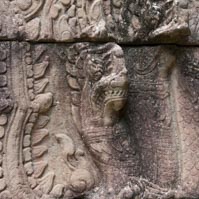
The German Angkor Imagery Project
• G • A • I • P •
The Khmer pronunciation of the "o" in "Ta Som" is a diphtong, consisting of an "a" like in "arch" and an open "o" like in "organ". "Ta Som" sounds a little bit more like "Ta Sowm" than "Ta Sorm", but not at all like "Ta Somm", though every driver or guide will understand you if you pronounce it this way as every other tourist does. Other spellings in use instead of "Ta Som" are "Ta Sohm" or "Ta Saum".
There was a stele in Preah Khan that probably mentions Ta Som, this is how the temple's original Sanskrit name was identified: Gaurashrigajaratna, "Propitious-Holy-Elephant-Jewel". A "shrigaja" is a white elephant, reserved for royalty. The inscription mentions the temple was home of 24 deities.
Ta Som is in the north-eastern corner of the Grand Circuit route, 2 km east of Neak Pean and 2,5 km north of the West Mebon. It was located slightly north to the east-west axis of Preah Khan and the "Preah Khan Baray". Ta Som lies at the foot of the Baray's embankment.
Ta Som is a medium-sized monastic complex, smaller than the similar Bayon-style temples Banteay Kdei, Ta Prohm, and Preah Khan. It is a typical structure of the era of the most prolific temple builder in Angkor's history, Jayavarman VII (1181- ca. 1218)
Ta Som is one of those monuments with face towers, but the colossal faces are of a smaller scale than at Angkor Thom. Ta Som's Buddha faces are on the Gopurams at the two entrances from the west and east. They mark the outer (third) enclosure, measuring 240 m by 200 m. This exterior enclosure may have been a later addition from the reign of Indravarman II in the first half of 13th century.
The eastern face-tower is one of the most often photographed Khmer monuments. For today's visitor starting at the car park it is just at the opposite end of complex. The tower is crowned by a superb example of Angkor's world-famous stone-cracking trees, a quite dramatic sight. The strangler fig still stands upright, but it died in the 1970s, this means it does not grow any more, due to decomposition it will fall down in a not too far away future. So hurry on to see the spectacular tree still upright on the monument.
The second enclosure is surrounded by a moat. Again, both gates, from the east and from the west, are Gopuram towers.
Ta Som's temple proper has laterite galleries surrounding the temple courtyard (inner enclosure), encompassing a cruciform Prasat sanctuary and two libraries built of sandstone. It is much like a miniature version of Ta Prohm, or a copy of its northern and southern side temples. The first (inner) enclosure is 30 m long and 20 m wide.
Many of the carvings are in a sound condition. They are of better quality craftsmanship than at contemporary temples. Bayon-style panels usually appear to be worked out more hastily. The Devata (Apsara) carvings show an uncommon individuality compared to other Bayon-style sculptures. A former pediment now on the ground to the south of the temple proper (inside the second enclosure) has a huge and lovely carving depicting the Bodhisattva Lokeshvara. The northern pediment of the North Gopuram, of similar size, was reconstructed recently by the WMF and the APSARA Authority. The south pediment of the north Gopuram (inside the inner enclosure) shows a smaller Lokeshvara, at his feet four praying figures on lotus buds. In the south-west section of the courtyard you can see more examples of excellent carvings on the ground and a pillar with a peg on the top. The symbolism is unknown. Similar stelae are found at contemporary temples, e.g. two at Preah Khan and one at Banteay Prei.
In 1998, the World Monuments Fund (WMF) began to stabilize the structure to make it safer for visitors.
Ernst Ando Sundermann
• G • A • I • P •
Copyright © 2021 khmer-heritage.de